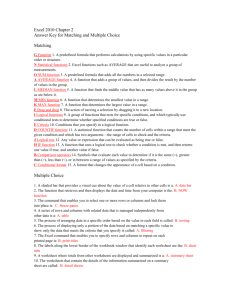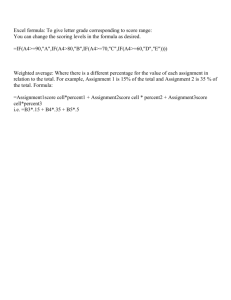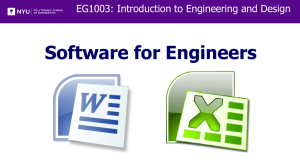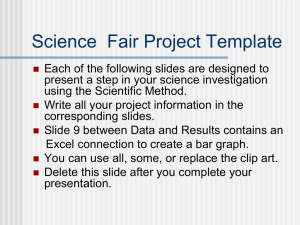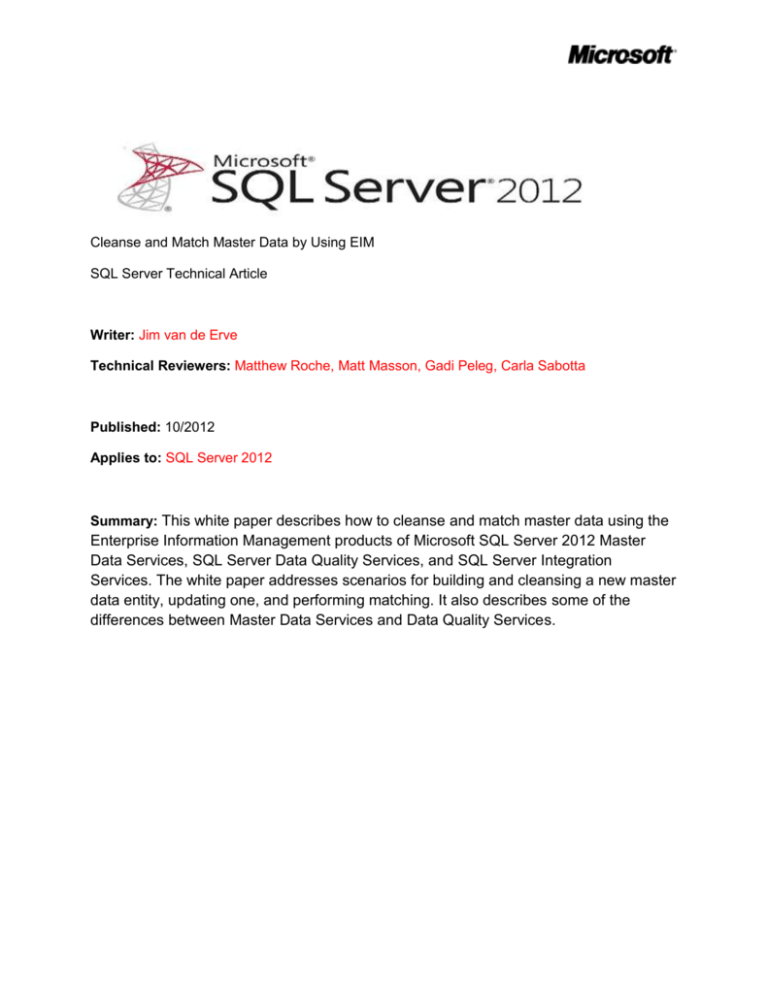
Cleanse and Match Master Data by Using EIM
SQL Server Technical Article
Writer: Jim van de Erve
Technical Reviewers: Matthew Roche, Matt Masson, Gadi Peleg, Carla Sabotta
Published: 10/2012
Applies to: SQL Server 2012
Summary: This white paper describes how to cleanse and match master data using the
Enterprise Information Management products of Microsoft SQL Server 2012 Master
Data Services, SQL Server Data Quality Services, and SQL Server Integration
Services. The white paper addresses scenarios for building and cleansing a new master
data entity, updating one, and performing matching. It also describes some of the
differences between Master Data Services and Data Quality Services.
Copyright
This document is provided “as-is”. Information and views expressed in this document, including URL and
other Internet Web site references, may change without notice. You bear the risk of using it.
Some examples depicted herein are provided for illustration only and are fictitious. No real association
or connection is intended or should be inferred.
This document does not provide you with any legal rights to any intellectual property in any Microsoft
product. You may copy and use this document for your internal, reference purposes.
© 2012 Microsoft. All rights reserved.
2
Cleanse and Match Master Data by Using
EIM
Master Data Services, Data Quality Services, and Integration Services:
Better Together
SQL Server 2012 Master Data Services and Data Quality Services help ensure the integrity of a
company's data. You store and manage master data using Master Data Services. You cleanse and match
data using Data Quality Services. You can use them independently, maintaining master data without
cleansing and matching it, or cleansing and matching source data without maintaining master data.
However, Master Data Services and Data Quality Services have complementary feature sets and are best
used in partnership. You can use the interactive and computer-assisted processes in both Master Data
Services and Data Quality Services to create and maintain master data of high quality. And you can use
them together with SQL Server Integration Services in an Enterprise Information Management (EIM)
solution that runs both the data quality and the master data management processes.
After describing how Master Data Services and Data Quality Services work together, this white paper
presents four scenarios in which you can cleanse and match master data using these EIM components:
Create and build a new master data model and an entity within the model that will contain the
data for a field, using Master Data Services and Data Quality Services
Update an existing master data entity in an EIM automated lookup scenario using Integration
Services, Master Data Services, and Data Quality Services
Include checks for close matches when updating an existing master data entity, by adding fuzzy
matching to the EIM automated update scenario
Perform matching on an existing entity from within the Master Data Services Add-in for Excel.
Tutorials that provide step-by-step procedures for cleansing master data can be found in the Tutorial:
Enterprise Information Management Using SSIS, MDS, and DQS Together whitepaper.
How Master Data Services and Data Quality Services work together
To describe how these features work together, here is a short description of what each of them does:
Master Data Services is a master data management platform that enables you to create and
maintain a single, authoritative standard for your business data. Using MDS, you can maintain
corrected data in a "known good" state through business rules and an Excel-based UI for
managing master data. By definition, master data is non-transactional reference data that
changes slowly. As such, master data empowers you to synchronize and resolve discrepancies
between source data systems. Master Data Services is where you store and manage master
data. From there, it is available to data stewards, information workers, and IT professionals. For
more high-level information about Master Data Services, see Master Data Services Overview.
3
Data Quality Services enables you to cleanse, enrich, and match data. DQS allows you to
improve the quality of your data by tracking rules and other knowledge about how to correct
problems in "dirty" data, and to apply that knowledge in interactive and automated scenarios.
Data Quality Services is a knowledge-based system that performs both computer-assisted and
interactive cleansing and matching processes using a knowledge base that you create. You can
build a knowledge base by adding your knowledge of the data, performing computer-assisted
knowledge discovery, and adding matching rules, which leveraging Data Quality Services
algorithms and industry reference data that are built into each knowledge base. You can also
build the knowledge gained in ongoing cleansing operations into the knowledge base, to achieve
and maintain a high standard of data quality. This results in a virtuous cycle of ongoing
improvement: the more you use a Data Quality Services knowledge base for cleansing, the
better it works for future cleansing tasks. For more high-level information about Data Quality
Services, see Introducing Data Quality Services.
Master Data Services provides tools and processes to maintain the integrity of the master data that is
stored in a Master Data Services model. You can enter changes to master data in the MDM UI, or
through the MDS add-in for Excel, and you can create business rules that validate incoming master data.
However, the focus in Data Quality Services on cleansing and matching data gives you much more data
cleansing power than the native features in Master Data Services do. Master Data Services and Data
Quality Services used together provide you with the technology that when combined with people and
processes deliver a full data curation solution. The automated and interactive processes of both
products empower the information worker to make the decisions that result in clean data.
Master Data Services and Data Quality Services give you multiple ways to perform cleansing and
matching operations. You can perform knowledge base management, cleansing, and matching directly
in the Data Quality Client. You can perform cleansing as part of an unattended batch operation by using
the DQS Cleansing, Lookup, and Fuzzy Lookup transformations in an Integration Services data flow. You
can perform matching by using the matching functionality in the Master Data Services Add-in for Excel,
which is based on Data Quality Services. These options give you the flexibility to choose the process that
fits your needs most closely.
To help you understand how Master Data Services and Data Quality Services work together to ensure
high-quality master data, this paper looks at four common implementations of these tools: one for
entering new master data in a new Master Data Services entity, and three for updating existing master
data as new data comes in.
Build a new master data entity by using Master Data Services and Data
Quality Services
When you first create a model and an entity in Master Data Services, and populate it with master data,
you want the data to be clean. Using Data Quality Services, you can create a knowledge base that is rich
with cleansing knowledge and matching rules, and then run cleansing and matching projects. These
4
steps are the best pathway to clean data. You make data decisions interactively in the Data Quality
client, using the computer-assisted processes that Data Quality Services provides to aid those decisions.
When you're ensuring the quality of master data, we recommend that you cleanse all your source data
before you do matching, and that you perform matching on the full set of source data. If you find and
correct as many problems with as much source data as you can, getting it as standard and consistent in
format as possible, you will increase your odds of finding genuine matching records. When working with
pre-cleansed data, the matching process will yield fewer false positives and fewer false negatives.
After you run cleansing and matching, you can then import the data into the Master Data Manager
(MDM), and going forward, use the Data Quality Services knowledge base by updating the data through
automated processes. Cleansing your data before you load it into Master Data Services enables you to
be fully aware of, and have full confidence in, your master data. After master data is stored inside
Master Data Services, you have more control over it. You can put Master Data Services business rules in
place to ensure that added or edited data conforms to your rules. You can import new data,
interactively using the MDS add-in for Excel or as part of a batch process using SSIS. Similarly, you can
export the master data using SSIS, or view and share master data using Excel. You can manually review
and modify the master data. Master Data Services is where you manage your master data going forward
so your source data systems can reliably depend upon it.
How building a new master data entity works
The following scenario creates and populates an entity in a master data model, uses Data Quality
Services to cleanse and match source data, and uses Master Data Services to publish it as master data.
5
To create and populate a new master data entity, and cleanse and match the master data, follow these
steps:
1. In Master Data Services, create a model for the master data. You could at this point create an
entity within the model that will contain master data members, but in this example scenario the
entity is created later in the Master Data Services Add-in for Excel.
2. Merge source data in an Excel spreadsheet or a SQL Server table, or using an Integration
Services package. If you have a lot of data to add, it's recommended that you do so in stages for
better performance. Cleanse and publish a subset of your entire data, and then repeat the
process for another subset. You do not have to merge all your data at once; the knowledge
discovery process can be performed iteratively with multiple sources, one after the other.
3. In the Data Quality client, create and publish a knowledge base for the data to be added as
master data, and create in the knowledge base one or more data quality domains each of which
will represent the data in a field. To do so, you can run knowledge discovery on a sample of the
6
4.
5.
6.
7.
data; add domain rules, term-based relations, and a composite domain; and add knowledge
manually to the knowledge base. Cover all of the data domains. Ensure that your knowledge
base covers all of the source data by running knowledge discovery on as many samples as
possible, importing corrections made during a cleansing process, and adding data values as
needed. Your domain should contain the same values you have in your source data. For more
information, see DQS Knowledge Bases and Domains.
Create a cleansing data quality project in the Data Quality client, and then run the data quality
project on the data that you want to add to the MDM. Changes with a confidence rating above
the auto-suggestion threshold, but below the auto-correction threshold, are suggested by the
system, but not automatically made. (Note that a dqs_administrator can change either of these
thresholds.) During the interactive cleansing process, you can manually approve or reject those
suggested changes in the output, and you can manually override auto-corrected changes. You
can then export the cleansed data to an Excel or .csv file or to a SQL Server table. The example
scenario covered by these steps creates an Excel output file. For more information, see Data
Cleansing.
In the Data Quality client, create a matching policy in the knowledge base. This involves adding
matching rules in an iterative testing process of establishing weighting, similarity, and
prerequisites. For more information, see Create a Matching Policy.
Run a matching project on the cleansed data. You can review the results and the profiling data,
approve or reject the matches, and specify a survivorship rule. At the end of the process, Data
Quality Services deletes records that match a survivor record, and then it exports the resulting
data to a file. Note that you will not have control over which is designated as the leading record
in a given cluster, but you can designate which record becomes the survivor record. For more
information, see Run a Matching Project.
Open the cleansed and matched data in Excel with the Master Data Services Add-in for Excel. In
the Excel Add-in, create an entity in the master data model created in step 1. When the entity is
created, the entity and the data in Excel is published to the Master Data Services model.
A tutorial with step-by-step procedures for creating a knowledge base, cleansing data, matching data,
and storing supplier data in Master Data Services can be found in lessons 1 through 4 in the Tutorial:
Enterprise Information Management Using SSIS, MDS, and DQS Together white paper.
When you perform cleansing and matching in Data Quality Services, the source data that you run them
on is not changed. The changes are saved in an Excel file, a CSV file, or a SQL Server table, which you can
then import into other applications or systems such as Master Data Services. If you save the data with
changes in an Excel file, you can publish the data from the Excel Add-in into the MDM model. If you save
the data and changes in a Master Data Services staging table, you can use entity-based staging to import
it into the master data entity by running the stg.udp_name_Leaf stored procedure. After it's in an entity
in the Master Data Services model, you can make changes to the master data manually in the Master
Data Services Web Application or the Master Data Services Add-in for Excel. (For more information, see
Master Data Manager Web Application.)
7
The Master Data Services Add-in for Excel is the easiest way to export data from, or publish data to, the
master data manager. However, if your data is very large, or if you will be importing or exporting as part
of an ongoing repeatable process, you may want to do this using a SQL Server table. For more
information about the differences between using Excel worksheets and database tables, see Import and
Export.
Update master data by using automation
Master data needs to be managed, enhanced, cleansed, and matched over time to ensure that it is kept
up to date. After master data has initially been imported into Master Data Services, you can run an
Integration Services package to perform ongoing updates of the master data, rather than running the
process manually in the Data Quality client. This has the advantage of limiting the interactive processes,
while still leveraging the computer-assisted processes of Data Quality Services and the knowledge base.
The scenario in this section describes an Integration Services package that uses the Lookup
transformation to compare the incoming updates with the existing master data. If no duplicate records
are found, the updated data is cleansed. After cleansing, another lookup is run to verify that the
cleansed data does not exist in the master data. The package then adds the data into a staging table for
review. You can import the approved data into the Master Data Manager using entity-based staging.
The lookup in the scenario in this section looks for exact matches. It does not generate approximate
matches of updates. That will be handled in the next section.
How updating master data using automation works
The following scenario updates the master data in an entity in Master Data Services. It uses a Lookup
transformation in an Integration Services package to ensure that duplicate records are not added to the
master data, and a DQS Cleansing transformation that runs an automated cleansing process. The
package stores new and unknown values in a separate location, making it easy for the data steward or
business user to review the values.
8
To update master data, follow these steps:
1. Ensure that your knowledge base covers all of the source data. You can enhance your
knowledge base with multiple sets of external source data by running knowledge discovery on
them.
2. Run an Integration Services package that does the following:
a. Imports source data, merging from multiple sources if applicable.
b. Uses a Lookup transformation to do a lookup comparing the new source data to the
existing master data values, using a subscription view as a source for the lookups and
using a business key attribute that is common between the entity data and the data
being imported. A subscription view is a view of the master data in an entity. This
process determines which records already exist in the master data, and so do not need
to be added. Being able to skip the addition of data that already exists helps improve
9
the performance of the cleansing process. There are variations on this step of the
scenario that a real-world implement would need to cover. An example is when
incoming data has the same key value, but different values in other attributes, as when
a record that was previously loaded into MDS has been updated in a source system so
that their values are no longer the same.
c. Runs the DQS Cleansing transformation to cleanse any records that were not found in
the Master Data Manager. When the Integration Services package runs the DQS
Cleansing transformation, it automatically creates and runs a Data Quality project.
If data is not corrected by Data Quality Services, the package stores it in a SQL Server
database staging table for a review by a data steward in the Data Quality client. The
data steward approves or rejects the data, and then can add approved data to the
master data. An SSIS developer could redirect corrected rows to one output path and
other rows to other output paths.
When an SSIS data flow that includes the DQS Cleansing transform is executed, a Data
Quality project is automatically created. A data steward can then open the project in the
Data Quality client application, review and approve (or reject) suggested corrections,
and save these corrections back into the knowledge base as new domain values or
synonyms. This “Cleanse to KB” process allows the data steward to be more involved in
these automated scenarios.
d. If the data is corrected by Data Quality Services, the package runs another lookup
transformation. If the updated data is not found in Master Data Services, the package
stores it in a SQL Server database staging table for a Master Data Services business data
review. You could load the data into Master Data Services at this point using entitybased staging, and have the data steward review it in the Web application.
3. If the business user approves a record, the data steward can add it to the master data entity by
performing entity-based staging. They do so by running the stg.udp_name_Leaf stored
procedure (where "name" is the entity name), which imports the data into the entity.
A tutorial with step-by-step procedures for automating the cleansing and matching of data using
Integration Services can be found in Lesson 5 in the Tutorial: Enterprise Information Management Using
SSIS, MDS, and DQS Together white paper. Note that the scenario in the tutorial differs in some ways
from the scenario outlined above.
Here's an example of an Integration Services package that updates master data using the preceding
steps. (This implementation was created by Matt Masson of Microsoft.)
10
This package handles failed cases gracefully. It includes a Conditional split transformation to separate
Corrected, Correct, and New values. Human intervention is required only if you need to decide, after the
package has run, whether to add the cleansed data to the Master Data Manager based upon your
business knowledge, and whether a record needs to be cleansed again interactively.
When you run the DQS Cleansing transformation, you don't have the opportunity to approve or reject a
corrected or suggested change generated by the Data Quality project, as you can in the Data Quality
client. You can, however, do so after the package has completed. You can review the changes in the
output, as is done in the scenario in this section. And as indicated in step 2c, you can open the data
quality project created by the execution of the DQS Cleansing transform in the Data Quality client just
like any other data quality project, and interactively cleanse the results in the project. You can then drive
the knowledge gained by running the project back into the knowledge base.
As the volume of data knowledge inside the knowledge base grows, the amount of user review that
needs to take place after the Integration Services package runs may become smaller and smaller. An
organization may have hundreds of thousands of records being cleansed by an Integration Services
package every day, yet only need a data expert to review just a few records manually.
After you have an Integration Services package that you run to update one entity, you can create
additional packages to update other entities. The new packages may require only minor configuration
changes from the first package, such as pointing the DQS Cleansing transformation to a different
knowledge base.
11
Perform matching on updated data
The Integration Services package for updating master data that is shown in the Update master data by
using automation section earlier includes a Lookup transformation process and data cleansing. The
lookup determines whether a record already exists as an exact duplicate in the master data. However,
while the Lookup component finds duplicates, it does not discover close matches for each record that is
a candidate to be added to master data.
The biggest matching issues may occur at the beginning of a project. For those issues, you can run
cleansing and matching, and then import the master data into a Master Data Services entity, as shown in
the Build a new master data entity by using Master Data Services and Data Quality Services section.
However, you may still want to run matching on updates. This section shows you how.
To run matching when updating master data, you have the following options:
Add a Fuzzy Lookup transformation to the Integration Services package
Perform matching manually within the Master Data Services Add-in for Excel.
Add a Fuzzy Lookup transformation
To add matching capability to the Integration Services package described earlier in the Update master
data using automation section, you can add a Fuzzy Lookup transformation. This transformation
performs a matching step that indicates close matches. Add the Fuzzy Lookup transformation after the
first Lookup transformation and the data cleansing transformation. If the record is not found in Master
Data Services by the first transformation, the package cleanses the data and then runs a Fuzzy Lookup
transformation. If an approximate match is found, the Fuzzy Lookup returns a key and the close
matches. The close matches are directed to a SQL Server database table. The data steward can then
decide which records to add to the entity.
How using a Fuzzy Lookup transformation works
The following scenario runs matching in an Integration Services package using the Fuzzy Lookup
transformation:
12
The Fuzzy Lookup transformation differs from the Lookup transformation in its use of fuzzy matching.
The Lookup transformation locates duplicate records in a reference table. The Fuzzy Lookup
transformation returns records with one or more closely matching records. A Fuzzy Lookup
transformation frequently follows a Lookup transformation and a DQS Cleansing transformation in a
package data flow. As with the cleansing process, the Lookup transformation helps improve the
performance of the Fuzzy Lookup transformation by limiting the number of records that have to be
matched.
For more information about the process in the workflow, see How updating master data using
automation works.
The Fuzzy Lookup transformation identifies matches using matching algorithms, but does not leverage a
knowledge base with a matching policy that you can interactively modify, as Data Quality Services
matching does.
13
A tutorial with step-by-step procedures for automating the cleansing and matching of data using
Integration Services can be found in Lesson 5 in the Tutorial: Enterprise Information Management Using
SSIS, MDS, and DQS Together white paper. Note that the scenario in the tutorial differs in some ways
from the scenario outlined above.
Run matching from the Master Data Services Add-in for Excel
Master Data Services provides you with the ability to run matching in the Master Data Services Add-in
for Excel. It runs matching on a dataset that can contain master data from the Master Data Manager as
well as data that is not managed by Master Data Services. This functionality leverages the matching
functionality in Data Quality Services, using a matching policy within a Knowledge Base to identify
potential matches. For records that it identifies as matches, it adds a cluster ID to the data in the
worksheet in Excel, and selects one of the records as the leading record. After matching has completed,
you can publish the changes back into the entity. You can choose to delete matched records, leaving the
leading record.
Using the matching capabilities in the Master Data Services Add-in for Excel is similar to running a
matching project in the DQS client. The user experience is different, and some functionality isn’t
implemented in the Excel Add-in, but the core matching functionality is similar. In the Master Data
Services Add-in for Excel, you cannot add matching rules and iteratively test and build the matching
policy, as you can in the Data Quality client. However, your particular scenario may dictate that you
should perform matching in the Excel Add-in. If you are adding updated data in Excel to other data
already in a master data model, it may be easier to do the matching inside the Excel Add-in after the
data is combined. For more information, see Data Quality Matching in the MDS Add-in for Excel.
How running matching from Excel works
The following scenario combines master data with source data that is not managed by Master Data
Services, and then it runs matching on the combined data in the Master Data Services Add-in for Excel:
14
To run matching from Excel, follow these steps:
1. In the Data Quality client, build a matching policy into the knowledge base using the updated
source data.
2. Copy source data that is not managed by Master Data Services into an Excel worksheet, and
then use the Master Data Services Add-in for Excel to load the master data from the Master
Data Manager into a second worksheet in Excel. Combine the data in the two worksheets into a
single worksheet using the Combine command in the Excel Add-in.
3. Run matching from the Matching command in the Excel Add-in. A Cluster_ID column is added to
the data, and a Source column indicating MDS (managed by Master Data Services) or External
(source data) is also added. You can add those new columns to the master data, and filter on
them.
4. Make any matching changes required in the combined data in the Excel file worksheet.
5. Publish the data from the Excel Add-in into the master data entity.
To run the matching process in the Master Data Services Add-in for Excel, you must designate either a
knowledge base that was already created or the default knowledge base. If you specify an alreadycreated knowledge base with a matching policy, the matching process will use all the matching rule
15
parameters specified in that policy, including similarity, weight, whether a value is a prerequisite, and so
on (see Create a Matching Policy).
If you do not specify a knowledge base that has a relevant matching policy, the Master Data Services
Add-in for Excel gives all of the fields the same weight, and uses that as a default matching policy. For
example, if you have five fields, each receives a 20 percent weight. You map columns in the worksheet
to domains in the knowledge base, and assign a weight value to the domains you choose. However,
these weight values do not persist after the matching process is complete.
The following figure shows the results of matching in the Master Data Services Add-in for Excel.
Instead of using Excel, as in this scenario, you could use SQL Server databases to export master data
from, and import it into, the master data model. You can cleanse and match master data that already
resides in the model by exporting it through a Master Data Services subscription view and consuming
the data in the Data Quality client. After you cleanse and match, you can import the updated data back
into a staging table, importing it using entity-based staging. Use the ImportType field in the staging table
to determine what to do when the staged data matches data that already exists in the entity.
16
Compare Master Data Services and Data Quality Services
This section describes some of the ways that Master Data Services and Data Quality Services differ in
their processes and some of the ways in which they are similar. Some of their functionality can overlap
because they are designed to work together and they are each designed to work without one another.
Both MDS and DQS play important roles in enterprise information management scenarios. DQS
emphasizes the cleansing, correction, and standardization of data through the collection of business
knowledge in a DQS knowledge base, and the application of that knowledge in interactive and
automated cleansing scenarios. MDS emphasizes the ongoing "care and feeding" of master data,
providing a set of tools that allow business users to keep records up to date, while allowing IT
departments to secure and manage the master data models, while integrating with external systems
that utilize the master data.
Import and export
Both Master Data Services and Data Quality Services have multiple ways to import and export data. They
both work with SQL Server and Excel, but they do so in different ways.
You have several choices for importing data into, and exporting data from, the MDM.
You can load master data from an entity into Excel, and you can publish data into a model from
Excel, by using the Master Data Services Add-in for Excel.
You can also import data from SQL Server staging tables by using entity-based staging.
You can export master data from the MDM into a subscription view.
Whether to use Excel or SQL Server to import or export master data is likely to depend on who is
performing the tasks, the size of the data, and whether the tasks are part of an automated process.
Information workers are likely to find the Master Data Services Add-in for Excel useful because
they are probably familiar with the product and used to performing manual tasks using it. IT
pros are likely to find SQL Server processes useful given their skill sets.
If you have a very large set of data, you are likely to want to use SQL Server processes rather
than Excel. At a certain point, a large set of data becomes unmanageable in Excel.
Entity-based staging and subscription views are easy to automate using SQL Server Integration
Services and Transact-SQL. If you need to bulk-load data into an entity, use entity-based staging.
Subscription views are used as a source for lookups because any data that goes into the MDM
automatically shows up in a subscription view.
As with Master Data Services, Data Quality Services has integration points using both Excel and SQL
Server.
17
You can cleanse data from SQL Server or Excel source files.
You can export cleansed data into a SQL Server, CSV, or Excel file.
You can import domains or values into a domain of a knowledge base by using an Excel file.
You can import or export a knowledge base or domain by using a .dqs file.
You can import values from a cleansing project (such as is created when the DQS Cleansing
transformation is run) back into the knowledge base used by the project.
Master Data Services business rules and Data Quality Services domain rules
Business rules in Master Data Services and domain rules in Data Quality Services are both used to
maintain the integrity of data, but they are used in different circumstances, as part of different
operations, and from within different tools. Domain rules are used to identify data problems as part of a
cleansing project, while business rules are used to prevent bad data from being introduced into Master
Data Services. The two types of rules can apply to the same data at different places in the information
management lifecycle, so the same rule can end up being defined in both places.
Domain Rules
A domain rule is used in the cleansing processes performed in Data Quality Services to identify
problematic records. Domain rules are established in the domain management performed in the Data
Quality client, and they are included in the applicable knowledge base.
A domain rule enables you to specify conditions for the data that you are cleansing. You can add rules to
specify values that are not allowed, and what the available values are or what the range of values is.
Each record you cleanse is validated against the rules that apply to the domains in the record. If a check
of a value fails, the value is marked as invalid.
Business Rules
A business rule is used in Master Data Services to prevent the entry of problematic records. Business
rules are created within the Master Data Manager Explorer, and they are part of the master data model.
A business rule prevents the improper entry or modification of records. It is not about identifying master
data within an entity that is already incorrect. It's about keeping bad data from being added to the MDM
or introduced within the MDM. Master Data Services will prevent you from entering a new record or
modifying an existing value if doing so would violate a business rule. Multiple processes trigger this
validation of master data. Whenever you add or change data into the MDM, whether it's through the
Excel Add-in, entity-based staging, the Web UI, or the API, applicable business rules are run on the
records that are added or changed. If you are manually making changes in the MDM, you can use a
business rule to validate the changes.
Conclusion
In this white paper, we have seen how you can use Master Data Services, Data Quality Services, and
Integration Services to cleanse and match master data, either manually (when building a new master
data model and entity) or in an automated process (using Integration Services when updating master
data). We have also seen how Master Data Services and Data Quality Services work together, their
differences, and their similarities.
18
Tutorials that providing step-by-step procedures for cleansing master data can be found the Tutorial:
Enterprise Information Management Using SSIS, MDS, and DQS Together whitepaper.
For more information:
http://www.microsoft.com/sqlserver/: SQL Server Web site
http://technet.microsoft.com/en-us/sqlserver/: SQL Server TechCenter
http://msdn.microsoft.com/en-us/sqlserver/: SQL Server DevCenter
See the following sections in SQL Server 2012 Books Online:
Master Data Services
Data Quality Services
Integration Services
Did this paper help you? Please give us your feedback. Tell us on a scale of 1 (poor) to 5 (excellent), how
would you rate this paper and why have you given it this rating? For example:
Are you rating it high due to having good examples, excellent screen shots, clear writing, or
another reason?
Are you rating it low due to poor examples, fuzzy screen shots, or unclear writing?
This feedback will help us improve the quality of white papers we release.
Send feedback.
19

